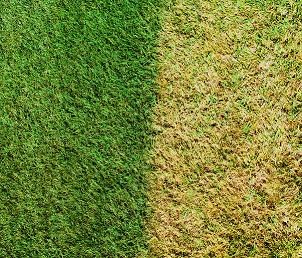
“How can I make my lawn greener?”
This question comes up a lot during my FREE garden consultations over the summer.
More often than not a lawn is suffering from a couple of problems: low nutrients, compaction, thick thatch, weeds, and drought.
There are two main routes to deal with the low nutrients and weeds:
One would be to start a fertilizer and weed spray regimen. You can call our office to get a price on our fertilizer and weed spray prices (952-252-3301).
The second option is a more natural, gradual, and labor intensive route.
Let’s say you’re suffering from all of the problems listed above. Here’s what I’d suggest:
1. Start with the compaction and thatch. Compaction limits grass root growth by limiting air and moisture levels and being too hard to push through. Thatch can similarly keep water and air from even reaching the soil surface. We solve compaction and thatch problems in one fell swoop with aeration (hyperlink to Aeration article). Aeration will pull plugs out of the compacted soil to let air and water reach grass roots.
2. Next, tackle low nutrient levels. Spread half an inch of compost over your lawn. Top dressing can be labor intensive but it helps add organic matter to your soil. Feed your soil and you will see your grass green up.
3. Now to choke out those weeds. Overseed! New seeds spread into that freshly aerated and compost-rich soil will take off. The best way to beat out weeds is competition – if you give your grass the advantages of food, water, and superior numbers it will win out against most weeds. If you still have trouble with some pernicious weeds then spot applications of an herbicide can be used to great effect.
4. Water away! Make sure your grass gets enough water – especially when the new seeds are growing and establishing. To stay green your lawn needs 1-2 inches of water per week and that water needs to penetrate 6 inches deep to encourage deep, healthy roots.
To find out how much you’re watering, put a small can in the grass under the spray and water for 30 minutes. If there isn’t half an inch of water in the can after 30 minutes then you need to keep watering. Time how much longer it takes to fill to half and inch.
Now that your lawn is wet take a 6-inch screwdriver and try to stick it all the way into the soil. If it goes in easily then you’re done – set your sprinklers to water your half-inch time twice a week. If it doesn’t go in easily try watering another 15 minutes and try again. However long it takes you to get your screwdriver in easily should be your watering time – set it up to go twice a week.
And remember to water in the mornings to help save water!
A few other tips.
Any projects that involve re-seeding should be scheduled for the spring or fall – summer seeders proceed at their own risk.
Give your lawn more organic matter. Don’t bag your clippings every time you mow your lawn let some of them settle back into your lawn to break back down into the soil.
Don’t mow so short – see if you like the way 3-4 inches looks. Longer grass will help shade out (and out compete) shorter weeds. It will also shade the soil and it’s roots – this will keep the ground cool and moist for healthier root growth. As a result your lawn also won’t need as much water.
Think you lawn needs help? Call or email Annika to get on our schedule!
Office: 952-252-3301
Email: Annika@PetersonLawn.com
Annika is the horticulturalist at Peterson Lawn Services. Call (952) 929-0422 to schedule a free garden consultation today!
Looking for fun gardening ideas – not sure where to start? Check out our Pinterest page: http://www.pinterest.com/petersonlawn/
Want more pictures on lawn care? Take a look at our Healthy Lawn board: http://www.pinterest.com/petersonlawn/a-healthy-lawn/
Be sure to “Like” us on Facebook: https://www.facebook.com/petersonlawnservices
